02-08-2020
Validation and Clinical Correlates of the Behavioral Indicator of Resiliency to Distress Task (BIRD) in a University- and Community-Based Sample of Youth with Emotional Disorders
Gepubliceerd in: Journal of Psychopathology and Behavioral Assessment | Uitgave 4/2020
Log in om toegang te krijgenAbstract
Distress tolerance (DT) is a transdiagnostic risk factor for psychopathology. The Behavioral Indicator of Resiliency to Distress (BIRD) task assesses DT by measuring task persistence in the face of distress. BIRD task performance has been associated with internalizing and externalizing symptoms in nonclinical youth, but these relationships have not been explored in clinical youth. Validating this task in a clinical sample would clarify its utility as a more objective indicator of DT. We aimed to investigate the correlates and predictors of BIRD task performance in a clinical sample of 348 youth assessed at pretreatment in community mental health clinics (CMHC; n = 209; ages 12–18; 66.8% female) or at a university-based research clinic (RC; n = 139; ages 10–18; 49.6% female). We aimed to evaluate the concurrent validity of the BIRD task by examining the associations between quitting the task and pre-task subjective units of distress (SUDs) and youth- and parent-reported anxiety, depressive, and externalizing symptoms, as well as youth-reported DT. Youth who reported greater subjective units of distress (SUDS) prior to the task reported greater anxiety and depressive symptoms, externalizing symptoms, and poorer DT. Those who quit the task early reported greater parent-reported school and separation anxiety. Surprisingly, fewer participants quit the task in this study compared with previous studies. The current results provide evidence that the BIRD may not be measuring the same construct as self-reported DT. Whereas a self-report measure captures one’s perceived ability to handle negative emotions, the BIRD captures one’s actual ability to persist in the face of frustration. These results suggest that youth’s perception of their ability to handle negative emotions may be distinct from their actual persistence when faced with distress. Assessing both perceived and actual DT may have clinical utility for youth with internalizing symptoms.
